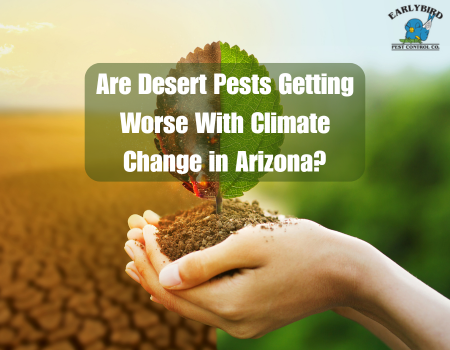Arizona’s beautiful desert landscape comes with its own set of unique challenges — and pests are one of them. From scorpions to termites, cockroaches to roof rats, Arizona homeowners have long dealt with a range of desert-dwelling critters. But in recent years, many residents and pest control professionals have noticed a troubling trend: desert pests seem to be getting worse. Could climate change be playing a role? Let’s explore what’s happening and what it means for Arizona homeowners.
How Climate Change Is Shaping the Desert Environment
Climate change isn’t just about rising global temperatures. It also influences precipitation patterns, drought cycles, and seasonal shifts — all of which can impact insect and animal behavior. Arizona, in particular, has experienced:
- Hotter, longer summers
- Milder winters
- Extended drought periods followed by intense monsoon rains
These environmental changes are creating new opportunities for pests to thrive, expand their territories, and survive through seasons when they might have once died off.
Which Pests Are Becoming More Problematic With Climate Change?
Several desert pests in Arizona appear to be benefitting from the region’s climate change:
- Scorpions
Scorpions, particularly the Arizona bark scorpion, are highly adapted to hot, dry climates. Warmer winters mean more scorpions are surviving year-round, increasing populations over time. Additionally, they often seek shelter indoors during heatwaves, driving up encounters in residential neighborhoods. - Termites
Termites, especially subterranean species, are thriving with the combination of drought-stressed plants and periodic heavy rains. Drier conditions weaken wooden structures and trees, while sudden moisture events encourage termites to swarm and establish new colonies. - Roof Rats
Traditionally more of an urban problem, roof rats are now spreading into new areas as temperatures stay warmer later into the year. Milder winters allow them to remain active, breed more frequently, and forage for food in outdoor spaces longer than before. - Mosquitoes
While Arizona isn’t known for heavy mosquito activity, changing monsoon patterns and urban water features have made standing water more common. This provides new breeding grounds for mosquitoes, some of which can carry diseases like West Nile virus. - Cockroaches
Heat-loving cockroaches, like the American and Turkestan varieties, are flourishing in rising temperatures. They can survive outdoors for longer periods and are more likely to invade homes in search of food, moisture, and cooler shelter during extreme heat.
Why Climate Change Favors Pests
Warmer temperatures, inconsistent rainfall, and drought-stressed landscapes create an ideal environment for many pests to reproduce rapidly and spread into new areas. Here’s why:
- Extended breeding seasons: Milder winters and longer summers mean many insects and rodents can remain active year-round, increasing their reproductive cycles.
- Weakened natural predators: Changes in the environment can reduce populations of animals that would naturally keep pest numbers in check, like birds, lizards, and spiders.
- Urban water sources: In arid regions, pests flock to homes and businesses with irrigation systems, pools, or standing water, especially as natural water sources become scarce.
- Shelter-seeking behavior: As outdoor conditions become too extreme — either too hot or too dry — pests move indoors for food, water, and shelter.
What Homeowners Can Do
Arizona homeowners don’t have to feel helpless in the face of growing pest problems. While climate change is a global issue, there are practical steps you can take locally to protect your property:
- Seal up entry points: Check for gaps around doors, windows, pipes, and vents, and use caulk or weatherstripping to close them.
- Eliminate standing water: Remove containers, unclog gutters, and fix leaking outdoor faucets to reduce mosquito breeding areas.
- Maintain landscaping: Keep trees, shrubs, and plants trimmed away from your home’s exterior and remove dead or decaying wood.
- Schedule regular pest inspections: Work with a licensed pest control professional to monitor and treat your home, especially during peak pest seasons.
- Reduce outdoor clutter: Clear away piles of wood, leaves, and debris where scorpions, rodents, and insects may hide.
The effects of climate change in Arizona’s desert regions are not only environmental but also ecological — and pests are adapting to these changes just as quickly as people are. While desert pests like scorpions, termites, and mosquitoes have always been part of life in the Southwest, their growing numbers and expanded seasons are becoming harder to ignore.
Staying proactive with home maintenance, pest prevention, and professional services will be key to keeping these unwelcome visitors at bay, even as climate conditions continue to shift. Being aware of how climate change affects pest behavior can help Arizona homeowners better protect their properties now and in the years to come.


Recent Comments